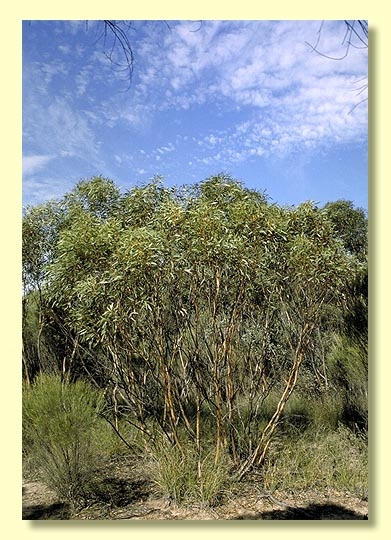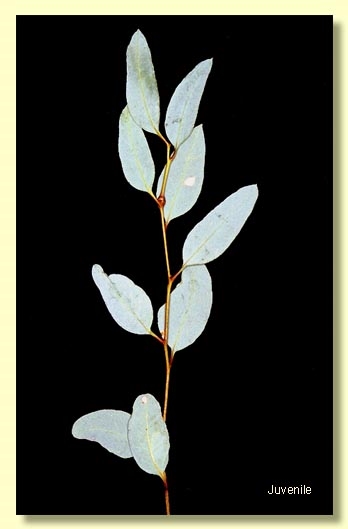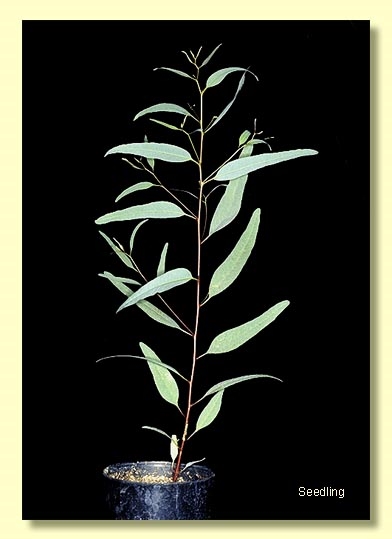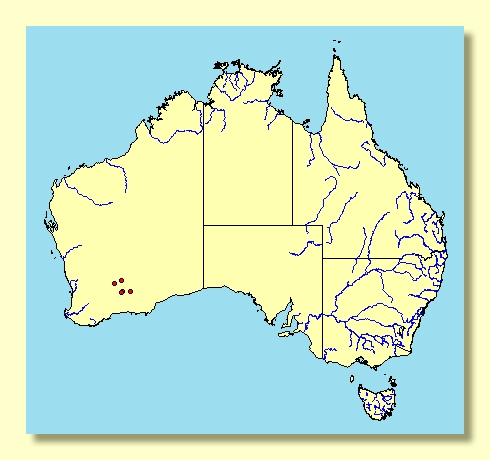Euclid - Online edition
Eucalyptus aspratilis
Eucalyptus | Symphyomyrtus | Bisectae | Glandulosae | Erectae | Pedicellatae
Eucalyptus occidentalis Endl. var. stenantha Diels ex Blakely, Key Eucalypts 110 (1934). T: near Lake Cowan, 1 Nov. 1901, L.Diels 5245; holo: NSW.
Eucalyptus occidentalis Endl. var. grandiflora Maiden, Crit. Revis. Eucalyptus 4: 149 (1919); Eucalyptus eremophila (Diels) Maiden var. grandiflora (Maiden) Maiden, Crit. Revis. Eucalyptus 7: 22 (1923). T: Kurrawang, W.A., Sep. 1915, J.B.Cleland 8161/15; holo: NSW.
Bark rough for up to 2 m of trunks, loose, flaky to ribbony, grey to blackish brown, sometimes smooth throughout, silvery grey to pale brown-grey.
Branchlets with oil glands in the pith.
Juvenile growth (coppice or field seedlings to 50 cm): stems rounded in cross-section; juvenile leaves always petiolate, alternate, ovate to lanceolate, 2.5–7 cm long, 1.5–2.5 cm wide, dull, blue-grey (not glaucous).
Adult leaves alternate, petioles 0.7–2 cm long; blade lanceolate, 5.5–10.5 cm long, 1–2.2 cm wide, base tapering to petiole, margin entire, apex pointed, concolorous, initially dull and bluish green maturing glossy green, side-veins at an acute or wider angle to midrib, reticulation sparse, clear, intramarginal vein present or obscure, oil glands numerous, island, rounded.
Inflorescence axillary unbranched, pendulous, peduncles narrowly angled to flattened and widest apically, 1.5–4.7 cm long, buds 7 per umbel, pedicellate (pedicels 0.4–0.8 cm long). Mature buds elongated to asymetrically fusiform (2–3 cm long, 0.5–0.7 cm wide), scar present (outer operculum shed early), inner operculum horn-shaped, 2 to 3 times the length of the hypanthium, stamens erect, anthers oblong, versatile, dorsifixed, dehiscing by longitudinal slits, style long and straight, stigma blunt, locules 4(5), the placentae each with 4 vertical rows of ovules. Flowers cream to pale yellow or yellowish green.
Fruit down-turned, pedicellate (pedicels 0.4–0.8 cm long), usually cylindrical or less commonly obconical, 1–1.5 cm long, 0.7–1.2 cm wide, disc level at first then descending, valves 4(5), held at rim level.
Seeds blackish brown, 1–2 mm long, ovoid to flattened-ovoid, dorsal surface shallowly reticulate, hilum ventral.
Cultivated seedlings (measured at node 10): cotyledons Y-shaped (bisected); stems rounded in cross-section; leaves always petiolate, opposite for 3 or 4 nodes, ovate to lanceolate, 5.5–9 cm long, 1.5–2.5 cm wide, dull, grey-green.
Flowering has been recorded in May, July and August.
A mallee endemic to Western Australia, occurring in the southern Goldfields from Coolgardie to the Norseman district and westwards towards Forrestania, occurring on sands at base of granite inselbergs. The bark is loosely rough on the stems, the adult leaves maturing glossy green with some side-veins visible and buds are elongated.
Eucalyptus aspratilis belongs in Eucalyptus subgenus Symphyomyrtus section Bisectae subsection Glandulosae because the buds have an operculum scar, cotyledons are bisected and branchlets have oil glands in the pith. Within this large subsection (ca 80 species) Eucalyptus aspratilis is closely related to a group of mallees and mallets (series Erectae subseries Pedicellatae) recognised by the glossy green leaf surface, leaves with many oil glands but not obscuring the secondary venation, peduncles long and flattened or terete, inflorescences spreading to pendulous and buds with a long operculum and erect stamens arising from a narrow staminophore.
Eucalyptus aspratilis is closely related to the more southerly rough-barked tree species E. occidentalis and differs from it in mallee habit, buds never in clusters of more than seven, cylindrical (not campanulate) fruit and narrower juvenile leaves. Other closely related species are E. sporadica which is a smooth barked mallee with buds in sevens and more obconical fruit, found to the south of the distribution of E. aspratilis in heath; and E. sargentii, a partly rough-barked tree with smaller buds in clusters of sevens on terete peduncles, restricted to saline depressions. Other species in series Erectae subseries Pedicellatae are: the smooth-barked mallets (trees) E. astringens (with 2 subspeceis) which differ in having shorter blunt buds, E. stowardii and E. diminuta which are mallees with longitudinally striate blunt buds and weakly ribbed fruit, E. thamnoides (with 2 subspeceis) a smooth-barked mallee with shorter blunt buds than E. aspratilis.
Within its natural range E. aspratilis might be confused with species of the E. eremophila group, viz. E. eremophila, E. tenera, E. tephroclada, E. incerata and E. depauperata, but these are always smooth-barked and have leaves so crowded with oil glands that the venation is obscured.













